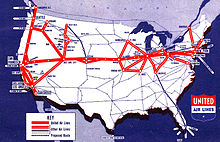United Airlines
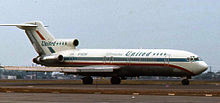

The History of passenger airliners and United Airlines, from the early 1970s. From the archives of the San Diego Air and Space Museum
History
United Air Lines, Inc., (NYSE: UAL), operating as United Airlines, is a U.S. airline and the world’s largest airline with 86,852 employees and operating the second-largest fleet with 702 aircraft. It is a subsidiary of United Continental Holdings, Inc. formerly, UAL Corporation, with corporate headquarters in Chicago. United’s largest hub is George Bush Intercontinental Airport inHouston. United is a founding member of the Star Alliance, the largest airline alliance in the world, and offers connections to over 1,000 destinations in over 170 countries worldwide. The airline’s regional service is United Express.
United Air Lines route map, 1940
United Airlines originated from the Varney Air Lines air mail service of Walter Varney, who also founded Varney Speed Lines which later became Continental Airlines. Founded in Boise, Idaho in 1926, the carrier flew the first Contract Air Mail flight in the U.S. on April 5, 1926, marking the first scheduled airline service in the country’s history. In 1927, airplane pioneer William Boeing founded his own airline, Boeing Air Transport, and began buying other airmail carriers including Varney Airlines. In 1929, Boeing merged his company with Pratt & Whitney to form the United Aircraft and Transport Corporation (UATC).
In 1933, United began operating the Boeing 247, which enabled passengers to fly across the U.S. without an overnight stop or changing planes. After passage of the Air Mail Act in 1934, UATC separated into United Aircraft (the future United Technologies), the Boeing Airplane Company and United Air Lines. During World War II, United-trained ground crews modified airplanes for use as bombers, and transported mail, material, and passengers in support of the war effort.
After the war, United gained from a boom in customer demand for air travel, with its revenue passenger-miles jumping five-fold in the 1950s, and continued growth occurring through the next two decades.
 United 727-200 in the Stars and Barslivery at Los Angeles International Airport in August 1974
United 727-200 in the Stars and Barslivery at Los Angeles International Airport in August 1974
In 1954 United Airlines became the first airline to purchase modern flight simulators which had visual, sound and motion cues for training pilots. Purchased for U.S.$3 million (1954) from Curtiss-Wright, these were the first of today’s modern flight simulators for training of commercial passenger aircraft pilots.
United merged with Capital Airlines on June 1, 1961 and displaced American Airlines as the world’s second largest airline, after Aeroflot. In 1968, the company reorganized, creating UAL Corporation, with United Airlines as a wholly owned subsidiary. The 1970s saw economic turmoil, resulting in “stagflation” and labor unrest. The 1978 Airline Deregulation Act, resulting in industry shakeups, further added to the carrier’s difficulties in a loss-making period.
In 1982, United became the first carrier to operate the Boeing 767, taking its first delivery of 767-200s on August 19. In May 1985, the airline underwent a 29-day pilot strike over management’s proposed “B-scale” pilot pay rates. Then-company CEO Richard Ferris changed United’s parent company’s name from UAL Corporation to Allegis in February 1987, but following his termination, the company reverted to the name UAL Corp. in May 1988, and divested non-airline properties.
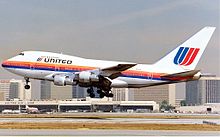 United 747SP in the 1974–1993 Rainbow Scheme
United 747SP in the 1974–1993 Rainbow Scheme
In 1985, United expanded dramatically by purchasing Pan Am‘s entire Pacific Division, giving it a hub at Tokyo’s Narita International Airport, and in 1991 purchased routes toLondon Heathrow Airport from ailing Pan Am, making it one of two US carriers permitted exclusive access to Heathrow under Bermuda II until “open skies” took effect in 2008 (American Airlines being the other, after purchasing TWA‘s Heathrow landing slots). The aftermath of the Gulf War and increased competition from low-cost carriers led to losses in 1991, and 1992. In 1994, United’s pilots, machinists, bag handlers and non-contract employees agreed to an Employee Stock Ownership Plan (ESOP), acquiring 55% of company stock in exchange for 15–25% salary concessions, making the carrier the largest employee-owned corporation in the world. The carrier also launched a low-cost subsidiary in 1994, Shuttle by United a high frequency, west coast-based operation, in an attempt to compete with low-cost carriers; the subsidiary remained in operation until 2001.
In 1995, United became the first airline to introduce the Boeing 777 in commercial service. In 1997, United co-founded the Star Alliance airline partnership. In May 2000, United announced a planned $11.6 billion acquisition of US Airways, but withdrew the offer in July 2001 before the United States Department of Justice barred the merger on antitrust grounds. May 2000 also saw a bitter contract dispute between United and its pilots’ union over pay cuts and concessions to fund the ESOP and overtime work, causing summer flight cancellations until a salary increase was agreed upon.
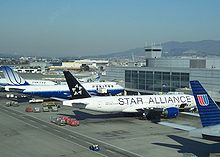 United planes, one with Star Alliance livery, at San Francisco International Airport, one of its main hubs.
United planes, one with Star Alliance livery, at San Francisco International Airport, one of its main hubs.
During the September 11, 2001 terrorist attacks, two of the four airplanes hijacked and crashed by al-Qaeda terrorists were United Airlines aircraft. An airline industry downturn resulted, and coupled with economic difficulties, skyrocketing oil prices, and higher labor costs, the company lost $2.14 billion in 2001. In the same year United applied for a$1.5 billion loan guarantee from the federal Air Transportation Stabilization Boardestablished in the wake of the September 11 attacks. After attempts to secure additional capital failed, UAL Corporation filed for Chapter 11 bankruptcy protection in December 2002 and the ESOP was terminated.
United’s bankruptcy operations resulted in furloughing thousands of workers, closing all U.S. city ticket offices, cancelling several existing and planned routes, downsizing its Miami operations, closing maintenance bases, and fleet reductions. The carrier also negotiated cost cuts with employees, suppliers, and contractors, and terminated feeder contracts with United Express carriers Atlantic Coast Airlines and Air Wisconsin. The carrier launched a new, all coach, low-cost carrier named Ted in 2003, and a luxury “p.s.” (for “premium service”) coast-to-coast service on re-configured 757s in 2004. In 2005, United cancelled its pension plan in the largest such default in U.S. corporate history.
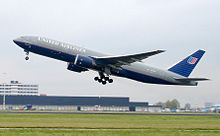 The first Boeing 777-200 in commercial service, United Airlines’ N777UA
The first Boeing 777-200 in commercial service, United Airlines’ N777UA
In 2005, United announced it had raised $3 billion in financing to exit bankruptcy and filed its Plan of Reorganization, as announced, on September 7, 2005. In late 2006, Continental Airlines participated in preliminary merger discussions with United. On June 4, 2008, United announced it would close its Ted unit and reconfigure the subsidiary’s aircraft for a return to mainline configuration.
On April 16, 2010, United resumed merger talks with Continental Airlines. The board of directors of both Continental and UAL Corporation‘s United Airlines reached an agreement to combine operations on May 2, 2010. The combined carrier would retain the United Airlines name, but use Continental’s logo and livery, and Continental’s CEO Jeff Smisek would head the new company. The merger was contingent upon shareholder and regulatory approval.

